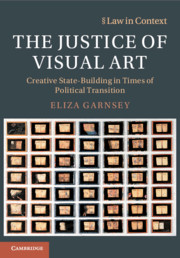Book contents
- The Justice of Visual Art
- The Law in Context Series
- The Justice of Visual Art
- Copyright page
- Dedication
- Contents
- Figures
- Acknowledgements
- Abbreviations
- 1 Introduction
- 2 Art and Justice in Times of Transition
- Part I Recognising Transitional Justice in the Nation State
- 3 From Prison to Court
- 4 Shaping ‘Legal’ Space
- 5 The Art of Recognition
- 6 The Visual Jurisprudence of Transition
- Part II Representing Transitional Justice on the Global Stage
- References
- Index
4 - Shaping ‘Legal’ Space
from Part I - Recognising Transitional Justice in the Nation State
Published online by Cambridge University Press: 17 October 2019
- The Justice of Visual Art
- The Law in Context Series
- The Justice of Visual Art
- Copyright page
- Dedication
- Contents
- Figures
- Acknowledgements
- Abbreviations
- 1 Introduction
- 2 Art and Justice in Times of Transition
- Part I Recognising Transitional Justice in the Nation State
- 3 From Prison to Court
- 4 Shaping ‘Legal’ Space
- 5 The Art of Recognition
- 6 The Visual Jurisprudence of Transition
- Part II Representing Transitional Justice on the Global Stage
- References
- Index
Summary
Chapter 4, Shaping ‘Legal’ Space, examines the spatial politics of the Constitutional Court of South Africa.The Court’s architecture and art collection are intended to symbolise the values of the Constitution. I explore five themes critical to justice which are dominant in the discourse of the Court – both in how people speak about the Court and in how the Court portrays itself. Four of these themes refer to values rooted in and fostered by the Constitution (accessibility, equality, dignity, and freedom of expression) while the fifth theme (justice under a tree) relates to a process of South African constitutionalism embedded in regional vernacular and post-apartheid identity formation. I analyse each theme by examining how its material manifestation – specific artworks and architectural features – intervene in the appearance and performance of the Court, shaping how the Constitution is understood in different ways. I argue that these material interventions and the space they create are key to the provision of justice at the Court.
Keywords
- Type
- Chapter
- Information
- The Justice of Visual ArtCreative State-Building in Times of Political Transition, pp. 56 - 85Publisher: Cambridge University PressPrint publication year: 2019

